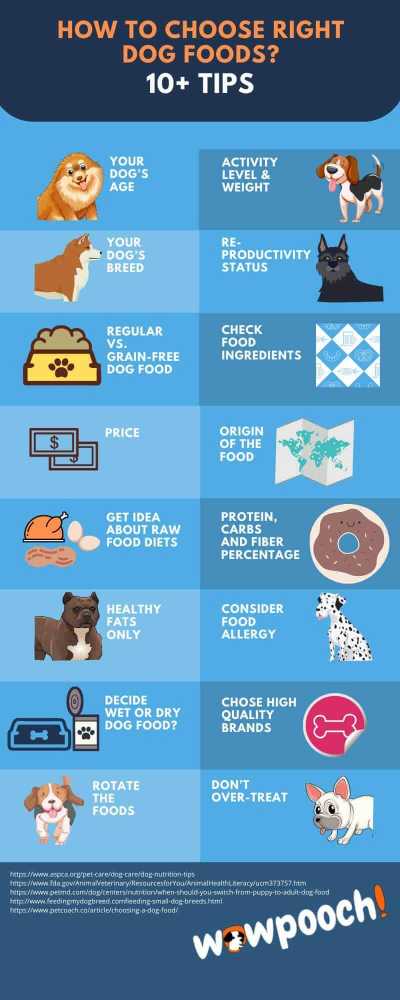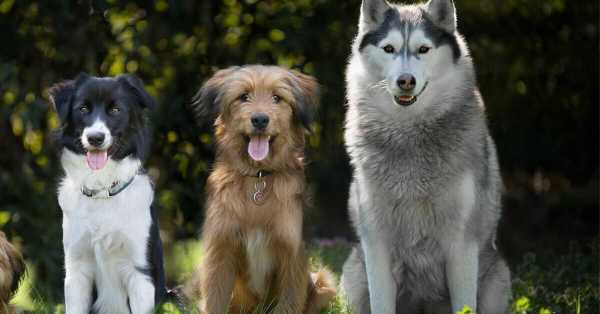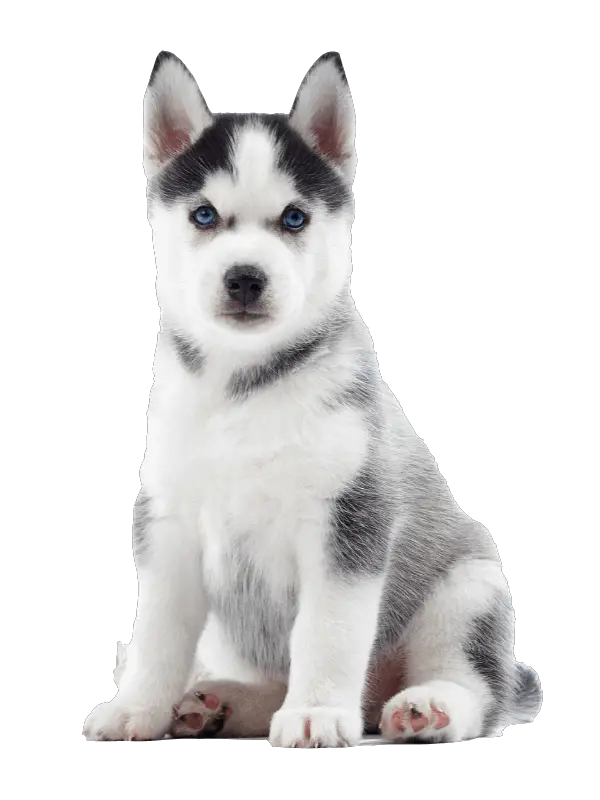As pet lovers, we know proper nutrition is the key to keeping our dogs as happy and healthy as possible. However, with so many options available, choosing the right food for our furry friends can seem a daunting task.
- Wet or dry?
- Raw or cooked?
- High in carbs or low in carbs?
- This brand or that brand?
With so many questions to consider, we’d be forgiven for throwing in the towel and simply grabbing the nearest option available.

But fear not… with a few simple tips, you can turn the hassle of choosing the right food for your pet into a breeze. Read on to discover my top 18 tips for choosing the best food for your pet.
Popular Read: What Are The Nutritional Needs Of Labradoodles?
List of Items

#1 Different Needs for Different Ages
When you’re deciding what to feed your dog, the first thing to consider is their age. Puppies require higher amounts of protein than adult dogs because their bodies are still growing and developing.
They also expend a lot more energy than adults… just look at how much they play!
If your pooch is 12 months or less, look for a dog food that contains high levels of protein and calories. Once your pup matures into adulthood, their calorie needs will be reduced.
To make it easy for you, most commercial pet food manufacturers offer their products in both adult and puppy versions… check the label to determine the best match for your pet.
#2 Pay Attention to Weight and Activity Levels
Feeding our pets the right quantity of food is just as crucial as feeding them the right quality. Always consult the feeding charts on pet food labels to check the recommended amount for your pet’s weight.
However, remember that weight is not the only deciding factor in how much food your pet needs; activity level is just as important.
If your dog rarely leaves the comfort of their basket, WebMD suggests they’ll need 10% less than the recommended amount.
Working or highly active dogs, on the other hand, may need 20- 40 % more. To avoid overfeeding, keep an eye on your dog’s activity level, and make any adjustments necessary to maintain their optimal weight.
Read: Best Dog Food To Gain Weight And Muscle

#3 Feed According to Breed
Smaller breeds have a very fast metabolism, meaning they burn calories almost as fast as they consume them. Look for foods that offer a high percentage of calories, protein, and essential fats per gram.
Medium and large-sized breeds will require high protein, high-calorie foods to fuel their energy demands. Aim for a mix of 24-40% protein and 14- 20% fat for optimal nutrition.
If this all sounds a little complicated, you’ll be pleased to know that many commercial pet food manufacturers, including Eukanuba and Royal Canin, now offer products specifically designed with different breeds in mind.
You’re not obliged to choose a breed-specific formula, but it may make life a lot easier if you do!
#4 Female Specific Needs
In the first 4-5 weeks of pregnancy, your dog will have the same dietary requirements as normal. During the last 3-4 weeks of pregnancy, however, the puppies will start to show rapid growth.
As this places greater nutritional demands on the mother, petplace.com recommends gradually increasing their food by 25-30%. If your dog is nursing, hillspet.com suggests that their energy requirements will be 4-8 times greater than normal.
To keep up with their needs, be sure to feed them high-calorie, high protein foods.
Many brands offer specially designed foods to support your dog’s changing needs during this period, so be on the lookout for formulas aimed at gestating or lactating dogs.
#5 Learn Some Label Lingo
If you’re daunted by the abundance of information on pet food labels, take heart… you’re not alone! However, all labels contain the same basic types of information; understand what these are, and you’ll be on the road to success.
The AAFCO enforces strict guidelines on what pet manufactures must include on their labels.
Required information includes product name, weight, manufacturer’s name and address, ingredient list, guaranteed analysis, nutritional adequacy statement, and feeding directions.
Of these, the key thing to consider is the nutritional adequacy statement, which proves the product has been thoroughly tested and proven to meet, or exceed, the AAFCO requirements for a complete and balanced food.
Check out the official AAFCO site for more information.
Learn How To: Schedule For Feeding Your Puppies

#6 A Grain-Free Diet: Is It Better?
According to CanineJournal.com, dogs have a difficult time digesting and metabolizing complex carbohydrates (the main nutritional element of grains). Over time, this can damage their digestive system, leading to such unpleasant conditions as food allergies, leaky gut, and inflammatory bowel disease.
Switching to a grain-free diet may reduce the occurrence of the diseases, and vastly improve your dog’s health.
If you’re concerned about the impact grains are having on your pet’s well-being, try removing them from their diet for a couple of weeks.
If you notice your dog’s coats getting shinier, their energy increases, and their food allergies disappearing, you’ll know you’re on the right track.
#7 Beware of False Advertising: Always Check the Ingredients
Although strict guidelines exist on how pet manufactures can advertise their food, it still pays to be vigilant.
First rule: always check the ingredients.
If the front of the pack says, “High in chicken”, check the list of ingredients to see how high up on the list chicken actually is. If it’s at the top, you’re on to a winner. If it’s more than halfway down the list, it may be best to look for another option.
Petcoach.co recommends you look for foods that have proteins such as meat or fish at the very top of the list, and with preservatives or flavorings at the very bottom.
Popular Reading : Can Dogs Eat Mangoes?
#8 When in Doubt, Speak to a Professional
If you’re struggling to know the best way to feed your dog, ask your vet for advice. They’ll be able to assess your dog’s weight, age, breed, and general condition to advise on the best diet for their needs.
Seeking professional advice is especially important if your dog suffers from any kind of chronic illness.
Diabetes, kidney disease, heart problems… these are all conditions that have very special dietary requirements, and it’s wise to speak to your vet before making any changes to your dog’s diet.
Don’t be tempted to take matters into your own hands- if you have any concerns about the effect of diet on your dog’s condition, be safe and take advice.
#9 Avoid Too Many Treats
If you’re one of the 40% of owners who like to indulge their pet with snacks, now might be the time to reconsider. The American Society for the Prevention of Cruelty to Animals recommends that treats make up no more than 5% of a dog’s daily calorie intake.
If you can’t resist, opt for low-calorie, high-fiber treats to prevent weight gain. Particularly healthy options include slices of raw vegetables or small morsels of meat.
Avoid feeding your dog table scraps or processed treats; not only can this encourage your dog to beg at the table, it can also provide a source of unhealthy fats and preservatives.
Check: What Are The Best Water Bowls For Dog?
#10 Understand the Risks of Raw Food Diets
While many pet owners are eager to espouse the benefits of a raw food diet, experts recommend a cautious approach to the trend.
A 2 year study by the US Food and Drug Administration discovered that raw pet food is a greater source of bacteria, including salmonella and listeria than other types of pet food.
The findings have prompted veterinary organizations such as the American Animal Hospital Association and the American Veterinary Medical Association to officially recommend against a raw meat diet.
If you’re intent on feeding your dog a raw food diet, consult your vet to establish the best, and safest, way to proceed.
#11 Don’t Underestimate Carbohydrates
Pet owners who shy away from grains are often reluctant to buy foods high in carbohydrates. But this owes to a popular misconception… a food rich in healthy fruit and vegetables can be high in carbs while containing no grain at all.
As an excellent source of energy and fiber, carbohydrates are a key factor in maintaining your dog’s health.
The fiber content of carbohydrate is particularly noteworthy: although not crucial to your dog’s diet in the way that protein or fat is, it’s a great way of keeping them feeling full for longer (ideal for pudgy pooches!): maintaining colonic health and helping control blood sugar (a key factor in diabetes avoidance and control).
Read: Best Dog Food Brands For Small Breeds
#12 Where, Who, How Much, and Why: The Importance of Brand
If you feed your dog commercial dog food, make sure to thoroughly research the brand before parting with your hard-earned cash. The internet offers a wealth of information on brand credentials (a good place to start is which contains comprehensive reviews of all the most popular pet foods).
It’s also good to speak to your vet, who can suggest specific brands trusted by the industry. They may even carry some options for sale.
Try to avoid buying your pet food from supermarkets; the brand availability will be limited, and you may only have a handful of options to choose between.
Where possible, buy from a reputable online source (but again, do your research!) or a reliable, local pet store.
#13 Tackle Food Allergies with Diet
If your dog is scratching like crazy, has wild flatulence, or seems to have never-ending ear infections, they may have a food allergy.
Many experts recommend an elimination diet (which removes all the common allergens from the diet) as the most effective way of identifying and treating a food allergy.
If your dog’s symptoms fade within a few weeks of beginning the elimination diet, you can try reintroducing the removed foods, one by one, to see how they react. Test their reaction after each new introduction; if they begin to show symptoms, you’ll know which food to eliminate from their diet on a permanent basis.
For more information on food allergies and elimination diets, check out:
Learn: What Dog Food Causes Allergies?
#14 Don’t Shun Fats
Don’t shy away from fat. As Dr. Rachel Barrack, DVM, CVA, CVCH of Animal Acupuncture in NY, says “Just as is true in humans, healthy fats are an important part of your dog or cat’s balanced diet”.
Healthy fats, such as those found naturally in meat, are a vital source of calories for dogs, while supplementary fats such as flax-seed oils and fish oils are high in immune-boosting, heart-healthy Omegas 3, 6, and 9.
WebMD.com advises a healthy diet should consist of a minimum of 5.5 % fat.
Read To Learn: Can Dogs Eat Cat Food?
#15 The Benefits of Rotational Feeding
If you find your pooch is less than enthusiastic at mealtimes, it may be a good idea to introduce some variety into their diet. After all, we don’t like eating the same foods every day, so why would our pets?
Rotating between foods on a regular basis is a great way of making sure your dog isn’t missing out on key nutrients, or even overloading on them.
Try switching brands every couple of weeks to see if your pet likes the change.
A word of caution: this approach won’t suit all dogs, so make sure to monitor their reaction to the change and only continue if they’re happy.
#16 Quality, Quality, Quality
If you’re on a tight budget, it can be tempting to reach for the cheapest can of dog food you see and damn the consequences.
If this sounds like you, think twice… low cost often equals low quality, and by feeding your dog poor quality, nutritionally imbalanced food, the savings you make today could cost you much more down the line.
A diet low in essential nutrients inevitably makes your dog more susceptible to illness, leading to more visits to the vet and, you guessed it, more money down the drain.
Feeding your dog a complete, balanced diet is the best guarantee of a long and healthy life… and of guarding against those pesky vet bills!
#17 Wet Food Versus Dry Food
Wet or dry… which is better?
Dry food is the most convenient and is a great tooth cleaner for dogs who hate having their teeth brushed.
On the downside, it has fewer calories than wet food, making it less ideal if your dog has high energy requirements. The high moisture content in wet food is helpful in preventing health problems like U.T.I’s.
Wet food also tends to have a higher protein content than dry food. On the flip side, wet food doesn’t clean the teeth in the same way as dry food. As you can see from
The answer to which is best is… it depends! Why not try your dog with both and see which they prefer?
#18 Nutrients: Pay Attention to Percentages
Dogs may be meat lovers, but they aren’t exclusively carnivorous; play close attention to the percentage of nutrients in your dog food to ensure a good balance of proteins, fats and carbohydrates.
The Association of American Feed Control Officials recommends puppies or pregnant and nursing dogs receive 22 percent protein in their diet.
Adult dogs should receive at least 18 percent. Fat should consist of 8 percent for puppies and pregnant or nursing dogs and 5 percent for adult dogs.
There is no minimum requirement for carbohydrates, but as carbs provide a great source of fiber, vitamins, and minerals, make sure to include a good selection of carb-rich foods in your dog’s diet for optimal health.
Check : What Dog Food Suitable For Pitbull Dogs?
What’s Your Favorite Tips?
As a proud spaniel owner and all-around animal fan, I love sharing hints, tips, and pearls of wisdom on the best ways to care for our furry little friends.
If you’ve found any of today’s tips particularly useful, and think your friends would to, please feel free to share the list around.
If you’ve already tried some of the tips and want to give your thoughts (or even add some extra ones to the list), please reply in the comments section below…. I’d love to hear your thoughts!
Other Dog Food-Related Topics
1. Best Dog Foods For Acid Reflux
2. Best Dog Food For Border Collie
3. Best Dog Food For German Shepherd
4. Best Dog Food For Yorkies
5. Best Dog Food For American Bully
6. Best Dog Food For Great Danes
7. Best Dog Food For Large Breeds
8. Best Tasting Dog Foods For Picky Eaters
9. Best Dog Food For Pomeranians
10. Best Dog Food For American Bulldogs
11. Best Dog Food To Gain Weight And Muscle
We have partnered with HungryBark.com to offer the best deal on high quality dog food to our readers. If you click on the button below, we will take you to their exclusive discount page.


